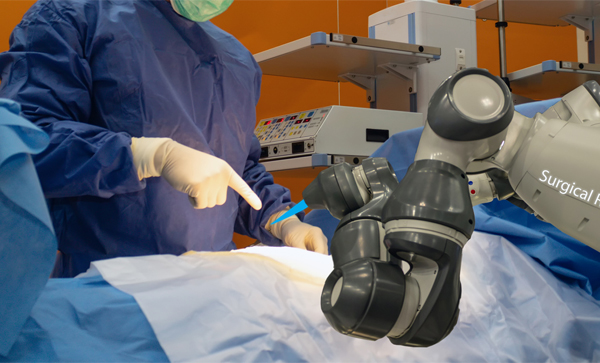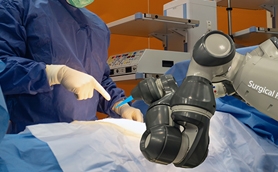
The demand for joint replacement surgeries in the United States is currently on the rise with number of knee replacements expected to increase by greater than 670% and hip replacements by greater than 170% by the year 2030. Wider adoption of robotics is helping surgeons meet this demand with a greater accuracy and consistency improving patient outcomes.
Joint replacement surgery involves the removal of damaged or arthritic components of the joint and their replacement with artificial metal or plastic components. Patients generally experience significant pain relief and improvement of joint function following the procedure. The implementation of robotics in joint replacement has many potential benefits, which include:
The use of robotics in hip and knee replacement has important benefits to patients:
- Improving accuracy of implant positioning giving a natural feel to the joint.
- Minimizing risk of injury to surrounding healthy anatomical structures.
- Smaller incisions resulting in faster healing and shorter hospital stay.
During joint replacement surgery, some part of the bone must be removed to fit the components of the prosthesis. In cases of traditional joint replacement surgery, a conventional cutting guide is placed across the bones of the joint and free hand cutting instruments are used to make cuts in the bone based on regional anatomy. Robotic systems use a computer-generated 3D model of the patient’s joint to determine exactly where the cuts in the bone are to be made.
Instead of plane 2D X-rays, robotic surgery involves the use of CT scanning to create the 3D images of the joint allowing for detailed pre-surgical planning and facilitating better execution. The surgeon can understand the unique anatomy of each patient and be in a better position to decide which implant will be the perfect match.
During the surgery, pins are placed into the bone which act as reference points, so the robotic system knows exactly where the joint is in space. Instead of just using the surgeon eyes, hands, and surgical tools; a sophisticated robotic arm (controlled by the surgeon) is used to cut and reshape the bone. If the surgeon wants to take a few millimeters off the bone, the robotic arm literally locks in the right position so that only the required amount of bone is removed as per the predetermined pre-surgical plan.
Dr. Paul Jacob uses the Mako robotic system, which is one of the most advanced robotics systems in orthopedic surgery today. It has been proven by several research studies to not only improve clinical outcomes, but also decrease failure and complication rates.
Dr. Jacob brings cutting edge techniques and technology to the Oklahoma City area. He has extensive training in minimally invasive, rapid recovery joint replacement as well as robotically assisted hip and knee replacement. Dr.Jacob is a pioneer in outpatient joint replacement allowing some patient to go home the same day as their procedure and recover in the comfort of their own home. The cornerstone of Dr. Jacob’s practice is to have the recovery process be easier, faster and less painful allowing his patients to get back into the game of life. Dr.Jacob is committed to bringing the highest level of orthopedic care while treating each and every patient like a family member. Providing you with patient centered care you can trust.













